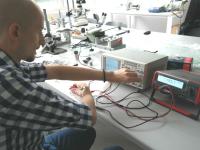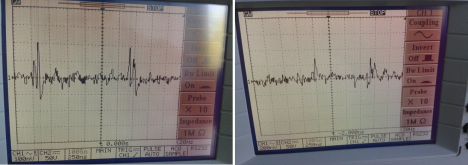Biomedical sensors - the future of diagnostics
How to quickly, easily and non-invasively measure pulse, check the level of electrolytes, blood sugar, urea, and even hormones? Using biomedical sensors attached to the skin. Andrzej Pepłowski - a PhD student at the Faculty of Mechatronics of the Warsaw University of Technology is working on such a solution.
Biomedical sensors are used to detect biological signals. One of them is the pulse wave that propagates in blood vessels. The sensor used to measure it is currently in prototype stage. “It was developed by D.Sc. Daniel Janczyk and I am in charge of its implementation and modifications," explains Andrzej Pepłowski.
Both researchers are in prof. Małgorzata Jakubowska's team, which works with printed electronics at the Faculty of Mechatronics of the Warsaw University of Technology.
Noticing interaction
The pulse sensor is printed on paper for temporary tattoos. During the examination, it’s attached to the skin together with a second layer (made of graphene nanoflakes), preferably on the wrist. “Under the influence of external forces we get a signal,” Pepłowski explains. This makes it possible to check the pulse.
However, this is only one of the parameters that biomedical sensors can monitor. They also include electrochemical sensors, which can detect a variety of chemical substances in the human body: electrolytes, blood sugar, urea, hormones. Until now these devices have only been tested in a laboratory, not yet on the skin. The team of prof. Elżbieta Malinowska from the Faculty of Chemistry of the Warsaw University of Technology is helping with their development (due to the different ways they function).
How can we check the level of any substance using such small devices? “What is happening at a biological level in the body, we translate into a measurable physical or chemical phenomenon,” Pepłowski says. “This might be an electrical signal, a change in colour, distortions... There are as many methods as there are phenomena. My task is to notice the potential interaction between the sensor and the organism, and then lead to a point when we will actually be able to observe it.”
In order to see the effects of the test, an appropriate way to communicate needs to be created. “We would like to use a smartphone,” Pepłowski explains. “The sensor is to be brought close to a telephone with an appropriate application installed, which will then show the result.”
Only a few seconds of testing
It is worth noting that the sensors the scientist from the Warsaw University of Technology is working on are not intended for laboratory measurements with an accuracy of many decimal places. The goal is to use them to monitor how the body behaves in different situations (e.g. to determine when a person is less or more stressed).
Such a use case makes significant sensor miniaturization possible. And this is only one of their advantages.
In addition, they are non-invasive, i.e. it’s not necessary to puncture the skin, deliver the sample to a laboratory and then wait for the test result. In this case, the measurement of chemical substances takes 1-2 seconds and the effect is instantaneous. “We're currently not capable of continuous monitoring of some diseases and physiological conditions,” Pepłowski adds. “Sometimes a test requires one to go to hospital for a day or two, samples are taken in the evening or morning, we're connected to some device and then diagnostics are performed. But these are not normal conditions for a person. Performing several measurements each day using the developed sensors will facilitate observations of changes in the body.”
The sensor's design is also a significant advantage. It has the form of an electronic tattoo attached to the skin, which in no way restricts the user, nor does it interfere with everyday life.
The technology used for the production of these devices is an important advantage of the device, one which is not visible at first glance. “We use printed electronics,” Pepłowski says. “The sensor arrays are made with a very simple printing technique and we only use as much material as we actually need. This enables large scale production and minimizes costs. With large scale manufacturing the cost of one sensor would be 2-3 cents. Even if it’s single use, it’s so cheap that its use is beneficial for the both the user and the producer.”
Collaboration full of challenges
Andrzej Pepłowski points out that it might even take 5 years before the devices he’s working on come to market. “Currently we’re trying to adapt the sensor manufacturing technology, so that within 2-3 years we can develop at least a few such devices,” he explains.
And there is no shortage of challenges. The key part is combining flexibility and low weight with durability. “The substrate we use is very thin and fragile, it looks like a type of paper or film,” says the researcher from the Warsaw University of Technology. “It’s easy to destroy the material, if you’re not careful. Meanwhile, the electronic circuit, which we then place on it using our printing technique, is supposed to withstand at least a few hours of use.”
Andrzej Pepłowski stresses that he’s a biomedical engineer and developing sensors requires the support of a variety of specialists. “I cooperate with colleagues who have extensive knowledge and assist with technological and chemical aspects,” he explains. “Our team also includes a doctor.”
Biomedical sensors could be the future of diagnostics. “We're getting signals from the medical industry that this is a valuable direction,” Pepłowski says. “I believe that the creation of such a solution will quickly receive widespread acceptance and interest from the field.”
Agnieszka Kapela
Office for Promotion and Information








